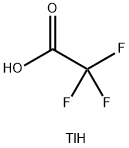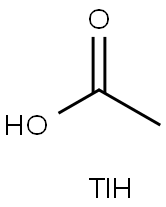THALLIUM(I) ACETATE
Synonym(s):Acetic acid thallium(I) salt;TlOAc
- CAS NO.:563-68-8
- Empirical Formula: C2H3O2Tl
- Molecular Weight: 263.43
- MDL number: MFCD00013045
- EINECS: 209-257-5
- SAFETY DATA SHEET (SDS)
- Update Date: 2024-12-18 14:08:57

What is THALLIUM(I) ACETATE?
Chemical properties
White to off-white fine crystalline powder
The Uses of THALLIUM(I) ACETATE
Thallium acetate is used in high specific gravity solutions to separate ore constituents by flotation. It was formerly used as a depilating agent by dermatologists via oral administration in cases of ringwormof the scalp, causinga number ofdeathsand poisonings.Thallium(I) acetate (0.1M) is used to enhance phosphorescence emission on laserinduced room-temperature phosphorimetry.
The Uses of THALLIUM(I) ACETATE
Acetic Acid Thallium(1+) Salt, is a Thalum salt, considere to be a hazardous material.It can be used as in Chemical Synthesis, Micro/NanoElectronics, and Materials Science.
The Uses of THALLIUM(I) ACETATE
Rodenticide, insecticide; fireworks dye; in optical glass; depilatory.
Definition
ChEBI: An acetate salt comprising equal numbers of acetate and thallium ions.
Production Methods
Thallium acetate is prepared from thallium(I) hydroxide or carbonate and acetic acid, which are then evaporated and recrystallized from alcohol.
General Description
White odorless crystalline solid. Density 3.68 g / cm3. A dangerous poison.
Air & Water Reactions
Deliquescent. Soluble in water.
Reactivity Profile
THALLIUM(I) ACETATE gives aqueous solutions that are basic (neutralize acids). These neutralizations generate only a little heat. Neither a strong reducing agent nor oxidizing agent, but can serve as both.
Health Hazard
Thallium is one of the more toxic elements both as an acute and a chronic poison. Effects of exposure are cumulative and onset of symptoms may be delayed 12 to 24 hours. May be fatal if inhaled, ingested or absorbed through the skin. Irritating to skin and eyes. Readily absorbed through the skin and digestive tract. Ingestion of soluble thallium compounds has caused many deaths. Ingestion of sublethal quantities may cause nausea, vomiting, diarhea, abdominal pain, and bleeding from the gut accompanied or followed by drooping eyelids, crossed eyes, weakness, numbness, tingling of arms and legs, trembling, tightness and pain in the chest. Loss of hair may occur in two to three weeks. Severe intoxication may cause prostration, rapid hearbeat, convulsions, and psychosis. Some effects may be permanent.
Safety Profile
Human poison by ingestion. Experimental poison by ingestion, intravenous, intraperitoneal, and subcutaneous routes. An experimental teratogen. Mutation data reported. When heated to decomposition it emits toxic fumes of T1. See also THALLIUM COMPOUNDS.
Properties of THALLIUM(I) ACETATE
| Melting point: | 124-128 °C |
| Density | 3.77 |
| storage temp. | Store at RT. |
| solubility | soluble in H2O, ethanol |
| form | Powder/Solid |
| color | White to off-white |
| Water Solubility | Soluble in water, alcoholSoluble in cold water, ethanol, chloroform and ether. Sparingly soluble in hot water. Insoluble in acetone. |
| Sensitive | Hygroscopic |
| Merck | 14,9257 |
| BRN | 3693914 |
| CAS DataBase Reference | 563-68-8(CAS DataBase Reference) |
| EPA Substance Registry System | Thallium(I) acetate (563-68-8) |
Safety information for THALLIUM(I) ACETATE
| Signal word | Danger |
| Pictogram(s) |
 Skull and Crossbones Acute Toxicity GHS06  Health Hazard GHS08  Environment GHS09 |
| GHS Hazard Statements |
H373:Specific target organ toxicity, repeated exposure H411:Hazardous to the aquatic environment, long-term hazard |
| Precautionary Statement Codes |
P260:Do not breathe dust/fume/gas/mist/vapours/spray. P264:Wash hands thoroughly after handling. P264:Wash skin thouroughly after handling. P270:Do not eat, drink or smoke when using this product. P273:Avoid release to the environment. P314:Get medical advice/attention if you feel unwell. |
Computed Descriptors for THALLIUM(I) ACETATE
THALLIUM(I) ACETATE manufacturer
New Products
4-Fluorophenylacetic acid 4-Methylphenylacetic acid N-Boc-D-alaninol N-BOC-D/L-ALANINOL Tert-butyl bis(2-chloroethyl)carbamate 3-Morpholino-1-(4-nitrophenyl)-5,6-dihydropyridin- 2(1H)-one Furan-2,5-Dicarboxylic Acid Tropic acid S-2-CHLORO PROPIONIC ACID ETHYL ISOCYANOACETATE 2-Bromo-1,3-Bis(Dimethylamino)Trimethinium Hexafluorophosphate (6-METHYL-[1,3]DITHIOLO[4,5-b]QUINOXALIN-2-ONE INDAZOLE-3-CARBOXYLIC ACID 4-IODO BENZOIC ACID (2-Hydroxyphenyl)acetonitrile 4-Bromopyrazole 5,6-Dimethoxyindanone 2-(Cyanocyclohexyl)acetic acid 4-methoxy-3,5-dinitropyridine 2-aminopropyl benzoate hydrochloride 1-(4-(aminomethyl)benzyl)urea hydrochloride diethyl 2-(2-((tertbutoxycarbonyl)amino) ethyl)malonate tert-butyl 4- (ureidomethyl)benzylcarbamate Ethyl-2-chloro((4-methoxyphenyl)hydrazono)acetateRelated products of tetrahydrofuran








You may like
-
 Thallium (I) Acetate CAS 563-68-8View Details
Thallium (I) Acetate CAS 563-68-8View Details
563-68-8 -
 Thallium(I) acetate CAS 563-68-8View Details
Thallium(I) acetate CAS 563-68-8View Details
563-68-8 -
 1975-50-4 98%View Details
1975-50-4 98%View Details
1975-50-4 -
 2-HYDROXY BENZYL ALCOHOL 98%View Details
2-HYDROXY BENZYL ALCOHOL 98%View Details
90-01-7 -
 2-Chloro-1,3-Bis(Dimethylamino)Trimethinium Hexafluorophosphate 221615-75-4 98%View Details
2-Chloro-1,3-Bis(Dimethylamino)Trimethinium Hexafluorophosphate 221615-75-4 98%View Details
221615-75-4 -
 61397-56-6 CIS BROMO BENZOATE 98%View Details
61397-56-6 CIS BROMO BENZOATE 98%View Details
61397-56-6 -
 14714-50-2 (2-Hydroxyphenyl)acetonitrile 98+View Details
14714-50-2 (2-Hydroxyphenyl)acetonitrile 98+View Details
14714-50-2 -
 118753-70-1 98+View Details
118753-70-1 98+View Details
118753-70-1